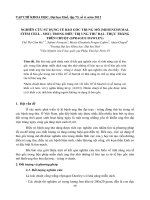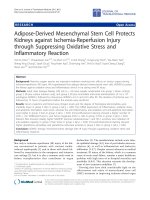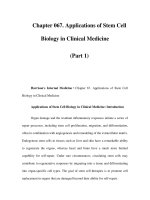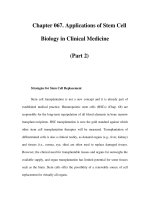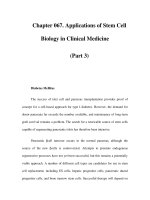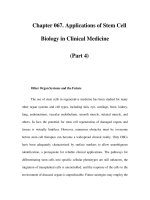Dynamic mechanical stimulation for mesenchymal stem cell chondrogenesis in an elastomeric scaffold
Bạn đang xem bản rút gọn của tài liệu. Xem và tải ngay bản đầy đủ của tài liệu tại đây (3.64 MB, 142 trang )
DYNAMIC MECHANICAL STIMULATION FOR
MESENCHYMAL STEM CELL CHONDROGENESIS IN AN
ELASTOMERIC SCAFFOLD
TIANTING ZHANG
(B.Sc., Zhejiang University, China)
A THESIS SUBMITTED
FOR THE DEGREE OFDOCTOR OF PHILOSOPHY
DEPARTMENT OF ORTHOPAEDIC SURGERY
NATIONAL UNIVERSITY OF SINGAPORE
2014
DECLARATION
I hereby declare that the thesis is my original work and it has been written by me
in its entirety. I have duly acknowledged all the sources of information which
have been used in the thesis.
This thesis has also not been submitted for any degree in any university previously.
_________________
Tianting Zhang
2014
ACKNOWLEDGEMENTS
I would like to sincerely express gratitude to my supervisors: Professor James Hui
Hoi Po, in Orthopaedic Surgery, National University Health System, Department of
Orthopaedic Surgery, Yong Loo Lin School of Medicine, National University of
Singapore, and Dr. Yang Zheng, Senior Research fellow, NUS Tissue Engineering
Program, Life Sciences Institute, National University of Singapore, for their guidance,
mentoring and encouragement during my post-graduate research. I amalso grateful to
Professor Tan Lay Poh and Dr. Wen Feng, School of Materials Science &
Engineering, Nanyang Technological University, Singapore, for their collaboration
and assistance in scaffold characterization and bioreactor operation.
I also appreciate the hearty support from all my colleagues Wu Yingnan, Antony J
DenslinVinitha, Deepak Raghothaman, Afizah Hassan and Ren Xiafei. Thanks to
Eriza Amaranto in NUS Tissue Engineering Program, for his good administration.
I am thankful for NUS providing me with a research scholarship and the patience and
support from administrative staff, Ms Low Siew Leng, Senior Manager, Department
of Orthopaedic Surgery, Yong Loo Lin School of Medicine, National University of
Singapore, Ms Grace Lee, Manager, Department of Orthopaedic Surgery, Yong Loo
Lin School of Medicine, National University of Singapore, and Ms Geetha Warrier,
Assistant Manager, Graduate studies, Dean’s Office, Yong Loo Lin School of
Medicine, National University of Singapore.
Last but not least, I am grateful to my parents, Jia Guoying and Zhang Weiming, for
their understanding and unwavering support, and my friend, Dr. Shi Pujiang, for their
company throughout the years of my PhD candidature.
TABLE OF CONTENTS
ACKNOWLEDGEMENTS.…… …………………………….…………………….i
TABLE OF CONTENTS.………………… …………………… ……………….iii
SUMMARY…………………………….……………………………… ………… ix
LIST OF TABLES………… ……………………………… ……… ……… xii
LIST OF FIGURES………………………… ………………………… ……….xiii
LIST OF ABBREVIATIONS……… ……………………….…… ……… … xvii
CHAPTER 1
1. INTRODUCTION…………………………… ……………………………… 1
1.1 Objectives ………… ………………………………………… … …………… 3
CHAPTER 2
2. LITERATURE REVIEW…………………………………… ……….…… 5
2.1 Articular Cartilage……………………………………………………… ……… 5
2.1.1 Articular Cartilage Structure, Composition and Function…………… ……5
2.1.2 Mechanical Properties of Articular Cartilage………………………… … 8
2.1.3 Articular Cartilage Damage………………………………… ………… 10
2.2 Current Clinical Cartilage Repair Strategies and Limitations……………… … 11
2.3 Cartilage Tissue Engineering……………………………………………… ….13
2.3.1 Stem cell based Approaches for Cartilage Tissue Engineering………… 13
2.3.1.1 MSC Chondrogenesis…………………………………… ……… 14
2.3.1.2 Growth Factors Selection in Cellular Approaches…………… … 17
2.3.1.3 Signaling Pathways for Cartilage Repair…………………… …….17
2.3.1.4 Hypertrophic Development in Chondrogenesis……………… … 21
2.3.2 Mechanotransduction in Cartilage Repair………………………… …… 23
2.3.3 Biomaterials for Cartilage Tissue Engineering………………… ……… 25
2.3.3.1 Natural Materials and Hydrogels……………………………… ….25
2.3.3.2 Polyester-based Synthetic Scaffolds……………………… ………26
2.3.3.3 Elastomeric Polymer……………………………………… ………27
2.3.3.4 Stratified Scaffolds…………………………………………… … 28
2.3.4 Mechanical Stimulation for Cartilage Tissue Engineering………… …….30
2.3.4.1 Compression and Shearing Stimuli…………………………… … 32
2.3.4.1.1 Compression…………………………………………… …32
2.3.4.1.2 Shearing……………………………………………… …… 32
2.3.4.2 Multi-axial Mechanical Stimuli……………………….……………33
2.3.4.3 Bioreactor Design…………………………………………… …….35
CHAPTER 3
3. MATERIALS AND METHODS…………………………………… ………….37
3.1 Scaffold Fabrication…………………………………………………… …… 37
3.1.1 PLCL Scaffold………………………………………………… …………37
3.1.2 Chitosan Coating of the PLCL Scaffold………………………… ……….38
3.2 Scaffold Characterization…………………………………… ………………….38
3.2.1 Fourier Transform Infrared Spectroscopy and Thermogravimetric
Analysis…………………………………………………………….………… 38
3.2.2 Porosity Measurement…………………………………… ………………39
3.2.3 Compression analysis and measurement of Recovery Ratio………………39
3.2.4 Scaffold Characterization - Scanning Electron Microscopy (SEM)…… 40
3.3 Cell culture and Chondrogenic Differentiation……………………………….…40
3.3.1 MSC Isolation and Culture………………………………………….…….40
3.3.2 Primary Chondrocyte Isolation and Culture………………………….… 41
3.3.3 ChondrogenicDifferentiation of MSCs in PLCL Scaffold………….……41
3.3.4 Mechanical Stimulation Set Up……………………………………….… 42
3.4 Assessment of Cell Attachment - Scanning Electron Microscopy………… … 46
3.5 Cell Proliferation………………………………………………………… …… 46
3.6 Histological and ImmunohistochemicalAssessment……………………… … 47
3.6.1 Safranin O staining………………………………………………… …….47
3.6.2 ImmunohistochemicalStaining…………………………………… …… 47
3.7 Fluorescent and ImmunofluorescentAnalysis…………………………… …….48
3.7.1 F-actin Staining………………………………………………… ……… 48
3.7.2 ImmunofluorescentStaining………………………………………… … 48
3.8 Quantification of Sulfated Glycosaminoglycan and Collagen Type II…… ……49
3.9 Real time PCR analysis……………………………………………………… …50
3.10 Western Blot assay……………………………………………………… …….51
3.11 Mechanical strength analysis………………………………………… ……… 52
3.12 Statistical analysis………………………………………………………… … 52
CHAPTER 4
Mesenchymal Stem Cell Chondrogenic Differentiation in Chitosan-coated
Poly(L-Lactide-co-Epsilon-Caprolactone) Scaffold
4.1 Background………………………………………………………… …….…….54
4.2 Results……………………………………………………………… ………… 54
4.2.1 Characterization of Scaffolds……………………………………… …….54
4.2.2 MSC Attachment, Morphology and Proliferation in the Scaffolds…… …56
4.2.3 Chondrogenic Differentiation of MSC and Cartilage ECM Formation in
the Scaffold……………………………………………………………… 58
4.2.4 Mechanical Strength of Harvested PLCL and PLCL/chitosan
Constructs…………………………………………………………………… 61
4.3 Discussion…………………………………………………………… …………61
CHAPTER 5
The effect of deferral dynamic compressiononmesenchymal stem cell
chondrogenichypertrophy development
5.1 Background…………………………………………………………… ……… 65
5.2 Results………………………………………………………………… ……… 65
5.2.1 ChondrogenicDifferentiation of MSCs and ECM Formation………… 65
5.2.2 Mechanical Strength of Constructs after Deferral Dynamic
Compression…………………………………….……………………….…… 68
5.2.3 Suppression of Hypertrophy under Deferral Dynamic Compression…… 68
5.2.4 Cell Morphology and Cytoskeleton Organization………………… …… 69
5.2.5 Regulation of TGF-β/SMAD Signaling Pathways……………… ……….71
5.2.6 Regulation of Integrin β1/FAK Signaling………………………… …… 72
5.2.7 Inhibition of TGF-β/Activin/Nodal Signaling by SB431542…… ……….74
5.2.8 Effect of TGF-β/Activin/Nodal Signaling Inhibition on Integrin β1/FAK
Signaling and BMP/GDP Branch Signaling………………………… … 75
5.2.9 Inhibition of Integrin Interaction on MSC Chondrogenesis and
TGF-β/SMAD Signaling Pathways……………………………………….……78
5.3 Discussion………………………………………………………… ………… 81
CHAPTER 6
The effect of dual-axis mechanical loading on MSC chondrogenic differentiation
in a bilayered PLCL/chitosan scaffold
6.1 Background…………………………………………………………… ……….88
6.2 Results………………………………………………………… ……………… 88
6.2.1 Characterization of Bilayered Scaffolds……………………… ………….88
6.2.2 Cell Proliferation, Distribution, and Morphology in the Scaffold…….… 89
6.2.3 Chondrogenic Differentiation of MSC and Cartilage ECM Formation in
the Scaffold………………………………………………………… …….90
6.2.4 Expression of Superficial Zone Cartilage Markers……………… ………93
6.3 Discussion…………………………………………………………… …………94
CHAPTER 7
7. CONCLUSION………………………………………………………… ……….99
7.1 Summary of Results…………………………………………………… ……….99
7.2 Recommendations for Future Work…………………………………………….102
7.2.1 Further Evaluation of BilayeredScaffold……………………… … …102
REFERENCES ………………… ……………………………….…… ……… 104
SUMMARY
Background: Mesenchymal stem cell (MSC) based cartilage tissue engineering for
treating articular lesion is of particular interest due to the multipotency for effective
chondrogenic differentiation. The various applications of three dimensional scaffolds
and mechanical stimulations aim to promote MSC chondrogenesis in every aspect
from cell attachment, proliferation to extracellular matrix (ECM) deposition and
mechanical properties.
Hypothesis: The general hypothesis of this thesis is that deferral dynamic mechanical
stimulation is able to enhance chondrogenesis, suppress hypertrophy and potentially
facilitate zonal distribution in the MSC constructs supported with stepwise upgraded
elastomeric poly L-lactide-co-e-caprolactone (PLCL) scaffolds. It was broken down
into three sections of investigation.
Methods: In vitro studies were conducted on MSC-seeded scaffolds. Chondrogenic
culture and mechanical stimulation of compression and dual-axis loading were
applied to constructs. The porous PLCL, unilayered PLCL/chitosan and bilayered
PLCL/chitosan scaffolds were characterized using SEM, FTIR/TGA and mechanical
tests. The cell-matrix constructs were evaluated by histological analysis,
chondrogenic/hypertrophic/zonal mRNAs expression, protein synthesis level and
mechanical strength analysis. Mechanism of mechanotransduction was studied
through assessing the regulation of pathway relevant molecules in TGF-β/SMAD and
integrin β1 signaling.
Results: In the first section, chitosan coating on PLCL scaffold increased
hydrophilicity, which further promoted cell spreading, attachment, distribution and
condensation. MSC-seeded PLCL/chitosan constructs showed increasing expression
of collagen type II (COL II) and aggrecan (AGCAN), as well as higher mechanical
strength. In the second study, deferral dynamic compression enhanced COL II and
AGCAN deposition and suppressed collagen type X (COL X), matrix
metallopeptidase 13 (MMP13), alkaline phosphatase (ALP) and Runt-related
transcription factor 2 (RUNX2) expression. A further investigation on TGF-β/SMAD
and integrin β1 pathways showed compression promoted phosphorylation of
SMAD2/3, but down-regulated phosphorylation of SMAD1/5/8, focal adhesion
kinase (FAK) and extracellular signal-regulated kinase (ERK). These molecular
modulations were confirmed by ALK5 and integrin β1 inhibition. In the last results
chapter, the application of deferral dual-axis (DA) loading to MSC-seeded bilayered
PLCL/chitosan constructs showed a decrease in AGCAN mRNA expression and an
increase in COL II staining in the layer with small pore (SP). Subsequent mRNA
analysis of zonal markers – collagen type I (COL I) and proteoglycan 4 (PRG4)
exhibited increased expression in SP layer under DA loading, indicating the
occurrence of ECM zonal deposition.
Conclusion: Deferral dynamic compression enhanced MSC chondrogenesis in
hydrophilic unilayered PLCL/chitosan scaffold, and inhibited hypertrophic
development. The mechanotransduction of compression initiated from transducing
extracellular physical loading into intracellular biochemical signals through integrin
β1 pathway. Then crosstalk between TGF-β/SMAD and integrin β1siganling leads to
chondrogenic enhancement and hypertrophic suppression through the antagonizing
roles of TGF-β/Activin/Nodal and BMP/GDP branches. The further application of
deferral dual-axis loading to bilayered PLCL/chitosan MSC constructs revealed
potential effect on zonal cartilaginous ECM constituents formation.
436 words
LIST OF TABLES
Table 1. Biomechanical properties of healthy human articular cartilage
Table 2. The list of primers used in real time PCR analysis
Table 3. Porosity, Wettability, and Mechanical Properties of PLCL and
PLCL/chitosan Scaffold
Table 4. Young’s Modulus and pore size of each layer in the bilayered
PLCL/chitosan scaffold
Table 5. Porosity and recovery ratio of unilayered and bilayered PLCL/chitosan
scaffold
LIST OF FIGURES
Fig 1.Schematic diagram illustrating the cross-section of healthy articular
cartilage.Adapted from A.S. Fox et al. 2009.
Fig 2.Cartilage zonal distribution of matrix constituents .Adapted from A. Hayes et al.
2007.
Fig 3. Depth-dependent loading exerted on articular cartilage.Adapted from J. M.
Mansour, chapter 5.
Fig 4. Correlation of compressive stiffness with the total glycosaminoglycan
concentration.Adapted from J. M. Mansour, chapter 5.
Fig 5. Involvement of biomolecules in the process of MSC chondrogenesis.
Adapted from I. Gadjanski et al. 2011
Fig 6. Schematic diagram of signal transduction by TGF-β/SMAD family. P. Dijke
and H. M. Arthur, 2007.
Fig 7. Schematic diagram of molecular pathways of chondrocyte
hypertrophy.Adapted from D. Studer et al. 2012.
Fig 8. Equation of the synthesis of PLCL statistical copolymers.Adapted from J.
Fernández et al. 2012.
Fig 9. Schematic diagram of designing development of stratified scaffold for
cartilage tissue engineering. Adapted from N. H. Dormer 2010.
Fig 10. Schematic diagram of structural stratified scaffold design.Adapted from
McCullen et al. 2012.(A) and Steele et al. 2013 (B).
Fig 11. Magnitude of cartilage deformation with different types of
activities.Adapted from F Eckstein et al. 2005.
Fig 12. Schematic diagram and snapshot of the bioreactor.
Fig 13. Schematic diagram of the experimental designs of(A) free swelling,(B)
deferral dynamic compression, and (C) dynamic dual-axis loading
conditions.
Fig 14. Setting window in ImageJ for measuring integrated density.
Fig 15. SEM microphotographs of PLCL and PLCL/chitosan scaffold.
Fig 16. FTIR and TGA spectrum of PLCL material, chitosan material and the
PLCL/chitosan scaffold.
Fig 17. SEM microphotographs of MSC attached on PLCL and PLCL/chitosan
scaffold 16hr after seeding.
Fig 18. F-actin organization of MSCs in PLCL and PLCL/chitosan scaffolds at 16
and 72 hr.
Fig 19. Alamar blue assay for proliferation of MSCs cultured on PLCL and
PLCL/chitosan scaffolds at 1, 3, 5 and 7 days.
Fig 20. Real time PCR analysis of chondrogenic marker SOX9, AGCAN and COL
II in MSC seeded PLCL and PLCL/chitosan constructs.
Fig 21. Quantification of AGCAN and COL II of MSC in PLCL and PLCL/chitosan
constructs after 2 and 4 weeks differentiation.
Fig 22. Histological and immunohistological staining with alcian blue, safranin O
and COL II for MSC seeded on PLCL and PLCL/chitosan scaffolds at week
4.
Fig 23. Young’s modulus of PLCL, PLCL/chitosan constructs at week 4.
Fig 24. Evaluation of ECM components (AGCAN and COL II) and mechanical
strength (Young’s modulus) of PLCL/chitosan constructs under deferral
dynamic compression at week 3 and 6.
Fig 25. Immunohistological staining of COL X and Real time PCR analysis of
hypertrophic markers - COL X, MMP13, ALP and RUNX2 at week 3 and
6 under free swelling and dynamic compression.
Fig 26. F-actin distribution and quantification of chondrocytes and MSCs in
PLCL/chitosan scaffolds under free swelling and dynamic compression.
Fig 27. pSMADs distribution and quantification in PLCL/chitosan construct under
free swelling and deferral dynamic compression at week 6.
Fig 28. Integrin β1 distribution and quantification in constructs under free swelling
and deferral dynamic compression at week 6.
Fig 29. Expression of ECM components and hypertrophic markers in
TGF-β/Activin/Nodal inhibition study.
Fig 30. The evaluation of pSMAD1/5/8, integrin β1 pFAK and pERK with
inhibition of TGF-β/Activin/Nodal signaling.
Fig 31. Expression of ECM components and hypertrophic markers with integrin β1
inhibition in free swelling conditions.
Fig 32. The distribution and quantification of pSMAD2/3 and pSMAD1/5/8 at
week 6 in free swelling samples with integrin β1 inhibition.
Fig 33. Schematic illustration of the possible cross-talks between TGF-β/SMAD
and integrin signaling in the regulation of MSC chondrogenesis and
hypertrophy.
Fig 34. SEM microphotographs of bilayered PLCL/chitosan scaffold.
Fig 35. Cell proliferation of bilayered PLCL/chitosan constructs scaffolds at 1, 3, 5,
and 7 days. F-actin staining in bilayered PLCL/chitosan constructs at day 1.
Fig 36. Real-time PCR quantification of chondrogenic markers - AGCAN and COL
II in bilayered PLCL/chitosan constructs.
Fig 37. Immunofluorescent staining and integrated density of COL II in the cells
under dual-axis loading.
Fig 38. Real-time PCR quantification of zonal markers - COL I and PRG4, in
bilayered PLCL/chitosan constructs of different layers under dual-axis
loading from week 3 to week 6.
LIST OF ABBREVIATIONS
Alkaline Phosphatase - ALP
Autologous chondrocyte implantation - ACI
Bone marrow derived mesenchymal stem cell - BMSC
Bone morphogenetic protein - BMP
Cartilage intermediate layer protein - CILP
Cartilage oligomeric matrix protein - COMP
Collagen – COL
Dual-axis - DA
Dulbecco’s modified Eagle’s medium – DMEM
Dynamic compression - DC
Embryonic stem cells - ES
Enzyme linked immunosorbant assay - ELISA
Extra-cellular matrix – ECM
Extracellular signal-regulated kinase - ERK
Fibroblast growth factor – FGF
Focal adhesion kinase – FAK
Fourier Transform Infrared Spectroscopy - FTIR
Free swelling - FS
Glyceraldehyde 3-phosphate dehydrogenase - GAPDH
Growth differentiation factor - GDF
Gross domestic product - GDP
Hyaluronic acid - HA
Indian hedgehog - Ihh
Induced pluripotent stem cells - iPSCs
Insulin-like growth factor - IGF
Insulin transferrin selenium - ITS
Kilopascal - kPa
Matrix induced autologous chondrocyte implantation - MACI
Megapascal - MPa
Mesenchymal stem cell - MSC
Messenger ribonucleic acid - mRNA
Neural cell adhesion molecule - N-CAM
Osteoarthritis - OA
Phosphate buffered saline - PBS
Polyethylene glycol - PEG
Proteoglycan – PG
poly L-lactide-co-e-caprolactone - PLCL
Polylactic-co-glycolic acid - PLGA
Polymerase chain reaction - PCR
Protein kinase C – PKC
ThermogravimetricAnalysis - TGA
1
CHAPTER 1
1. Introduction
Articular cartilage is an avascular connective tissue which lacks self-repairing
capacity (Hunziker, Quinn, & Hauselmann, 2002; Muir, 1995). Existing clinical
approaches to treat cartilage defects are unsatisfactory in terms of the functional
inferiority(Keeney et al., 2011, Aigner and Stove,2003).Hence, tissue engineered
cartilage repair with or without scaffold as a promising treatment has been
progressively investigated(Ahmed and Hincke, 2010, Hunziker, 2009). However, the
major cell-based method, autologous chondrocyte implantation (ACI), suffers from
the limitation of defect size, risk of donor-site morbidity and loss of chondrocyte
phenotype during monolayer expansion(Smith, Knutsen, & Richardson, 2005). Bone
marrow derived mesenchymal stem cells (MSCs), with high proliferative capability
and the ability to differentiate to chondrocytes, have been considered as a potential
alternative cell source. However, the biological characteristics and mechanical
properties of engineered neocartilage using MSCs are still less optimal than the native
cartilage. Although a wide variety of bioactive factors, scaffold manipulation, and
culture conditions has been study to promote MSC cartilage formation, effective and
reliable strategies yielding tissues with properties matching those of native cartilage
have not been developed (Keeney etal., 2011, Kock et al., 2012).
Chondrogenesis of MSCs involves cell recruitment, migration, condensation,
chondrocyte differentiation and maturation (Goldring, Tsuchimochi, & Ijiri, 2006).
2
This process is precisely controlled by growth factors, transcriptional factors, cell-cell
and cell-matrix interactions and other environmental factors (Goldring et al., 2006;
Mahmoudifar & Doran, 2012; Woods, Wang, & Beier, 2007).Under physiological
conditions, articular motion subjects cartilage to a range of mechanical loading such
as compressive and shear force, and hydrostatic pressure, causing cell and tissue
deformation and changes in fluid flow (Kock et al., 2012). Physiological loading is a
pivotal factor influencing the chondrogenic differentiation of MSCs during articular
cartilage development, modulating the properties of the cartilage by triggering
anabolic tissue responses with increased synthesis of ECM components. Cartilage
regeneration strategies must therefore take into account the biomechanical
environment and physical stimuli. Despite increasing evidence that shown the
influence of mechanical stimulation during MSCs chondrogenesis (Grad, Eglin D Fau
- Alini, Alini M Fau - Stoddart, & Stoddart, 2011; Mouw, Connelly, Wilson, Michael,
& Levenston, 2007),there remains a huge gap in understanding the contributing
factors of mechanical stimulation in regulating MSC chondrogenesis, especially the
mechanotransduction relationship of how physical stimulation is transduced into
biological signaling, and regulates the intracellular signaling cascades.
In order to study the modulation of physical forces on chondrogenesis, a proper
elastomeric scaffold, with desirable mechanical properties, including good recovery
ratio, is required to support cellular functioning and tissue formation under the
dynamic mechanical stimulation. A 3D porous poly L-lactide-co-e-caprolactone
(PLCL) scaffold that has been previously shown to possess characteristics of
3
biocompatibility and elasticity, and supports chondrocytetissue formation, was
employed as the scaffold platform for this study. Subsequently, dynamic mechanical
stimulation would be employed on the stepwise updated PLCL scaffold with MSC
seeding. Themechanisms involved in compression-driven chondrogenic reinforcement
and hypertrophic abatement would be explored. With the better understanding of
mechanotransduction, a further stratified PLCL scaffold would be subjected to
dynamic dual-axis loading. As the scaffold was characterized, the effect of complex
compression plus shearing loading on the constructs would be investigated in aspects
of chondrogenesis and ECM zonal distribution.
1.1 Objectives
To summarize, following gaps exist in mechano-induced chondrogenesis:
Uniform scaffold, e.g. hydrogel and synthetic solid polymer, is unable to meet
with the requirements of elasticity and mechanical strength.
Hypertrophy is an inevitable stage inMSC chondrogenesis. However the tissue
development from hypertrophic chondrocytes is functionally inferior to native
articular cartilage.
Mechanotransduction ispartially understood. The existing reportsonly
provided limited and incomplete explanation of how physical force is
translated into biochemical signals.
The application of bilayered porous PLCL/chitosan scaffold to compression
and shearing combined mechanical induced chondrogenesis are scarcely
4
reported. Besides, the effect of this dual-axis mechano-stimulation has been
insufficiently characterized.
In this thesis, the objectives of the study are as follow:
To fabricate and modify porous PLCL scaffold with elasticity and mechanical
strength, which is desirable for dynamic compression and shearing test;
To investigate the cell morphology, cytoskeleton arrangement, chondrogenic
differentiation and zonal phenotypes in the constructs under mechanical
stimulations, i.e. deferral dynamic compression and dual-axis loading;
To understand how dynamic compression mediates chondrogenesis through a
biological mechanism study on TGF-β/Smad and integrin β1 signaling, and to
map the crosstalk among the signal cascades in mechanotransduction of
chondrogenesis.
5
CHAPTER 2
2. Literature Review
2.1 Articular Cartilage
Articular cartilage is a connective tissue that covers the ends of the bones in joints.
It is devoid of nerves and blood vessels. This simple structured tissue, however,
provides lubricating and frictionless motion for articulation. This section introduces
the basic structure and function of articular cartilage, followed by the description of
cartilage damage, in order to elicit the discussion of current and prospective treatment
strategies.
2.1.1Articular Cartilage Structure, Composition and Function
Articular cartilage is a resilient tissue with the function of wear resistance and
load bearing to facilitate smooth joint motions(Sophia Fox, Bedi, & Rodeo, 2009). It
also refers to hyaline cartilage because of the pearly translucent color. Articular
cartilage has a hierarchical structure, and the thickness ranges from 2 to 4 mm in
humans (Adam et al., 1998 ). It is composed of an extracellular matrix (ECM) with a
sparse distribution of highly specialized cells called chondrocytes. The ECM exhibits
a biphasic property with approximately 80% fluid phase and 20% solid phase. The
fluid is composed of 80% water, and the rest consists of 10%–15% collagen (mainly
collagen type II (COL II)), 5%–10% cartilage-specific proteoglycans (PGs) –
aggrecan (AGCAN) with their highly sulfated glycoaminoglycans (sGAG), and other
